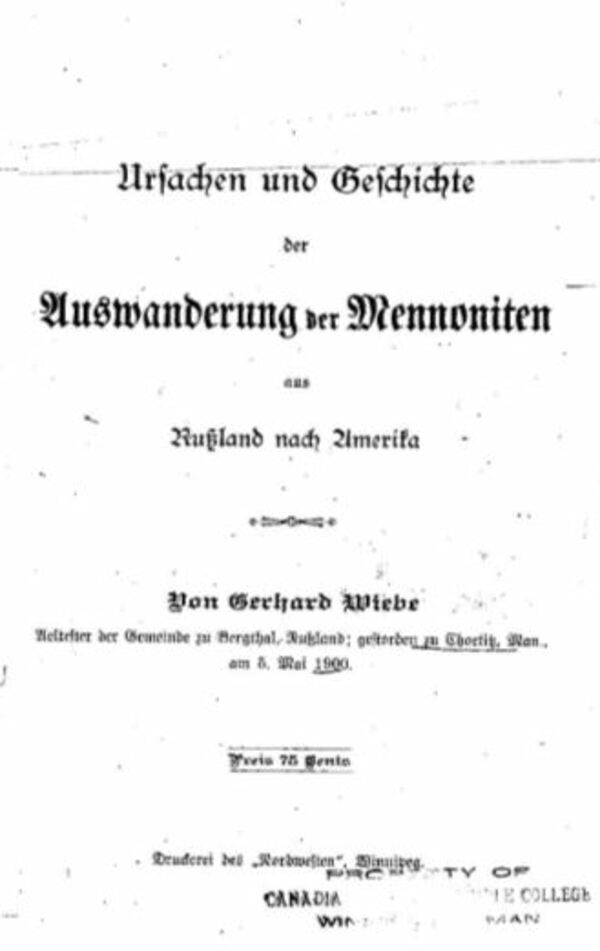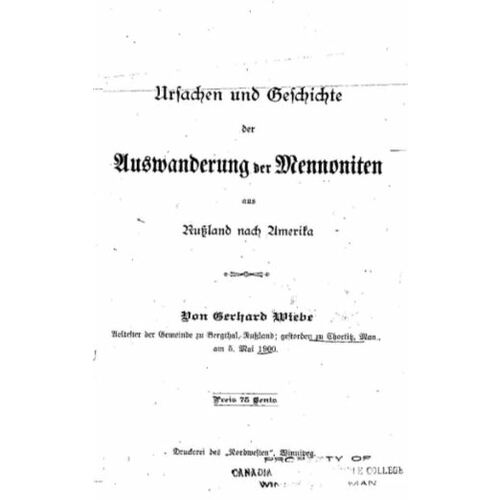
Source: Link
WIEBE, GERHARD, farmer, Mennonite bishop, and author; b. 25 July 1827 in the Chortitza Mennonite settlement (near Zaporozh’ye, U.S.S.R.), eldest child of Gerhard Wiebe and Agatha Dyck; m. 12 June 1847 Elizabeth Dyck in the Bergthal Mennonite settlement, near Mariupol (Zhdanov, U.S.S.R.), and they had two daughters and eight sons; d. 3 May 1900 in Chortitz (Randolph), Man.
Gerhard Wiebe’s forebears had immigrated in 1789 to the Mennonite settlement of Chortitza from the region of Gdańsk, Poland, as part of a large movement of western Europeans into Russia in the second half of the 18th century. He grew up in this German colony in relative isolation from the larger Russian society. Like all Mennonite children of his time, girls and boys alike, he attended the elementary school which the Mennonite Church operated in each village and he learned the basics of reading, writing, arithmetic, and religion. This schooling was usually completed in six years.
Since Russian law prohibited Mennonite heads of families from subdividing their basic landholding of approximately 175 acres, many villages soon included a number of landless families whose economic (and often social) status as labourers was lower than that of peasant farmers. Wiebe’s parents probably belonged to this landless class, since they and their children moved to the Bergthal settlement, southeast of Chortitza, when Gerhard was 12 years old. This new settlement, founded in 1836, was the first Mennonite colony established to alleviate the pressure of the landless families living in Chortitza. It eventually consisted of five villages. Partly as a result of his family’s move, Wiebe did not enter any of the secondary schools which the older Mennonite colonies had established. He did, however, continue his education on his own.
Of his career as a farmer in the Bergthal colony little is known, other than that he was the owner of a full farm of about 175 acres. His notable contributions were made as a leader of the church. On 26 May 1846 he was baptized on his confession of faith. Eight years later, at age 27, he was chosen deacon. On 23 Dec. 1861, at age 34, he was ordained minister, and on 27 March 1866 he became the second bishop of the Bergthal Mennonite Church.
Important political and social changes were taking place in Russia during the 1860s, including the emancipation of serfs and an increasing sense of Russian nationalism. As a result, Mennonites, along with other foreign colonists, lost many of their special privileges. To Wiebe, the compulsory introduction of the Russian language in schools and in the administration of colonies, and the threatened loss of complete exemption from military service, seemed intolerable. As a leader of his church, comprising some 3,000 souls, he soon became an advocate of emigration. Although only about one-third of the Mennonite population in Russia chose to leave, Wiebe persuaded the entire colony of Bergthal to immigrate to Canada during the years 1874 to 1876. Wilhelm Hespeler*, a special immigration agent of the Canadian government, was instrumental in bringing the Mennonites to Manitoba. Wiebe himself left Bergthal with a group of 50 families. They landed in Quebec in the summer of 1875 and joined those who had arrived earlier, settling in the East Reserve, a block of eight townships east of the Red River in southern Manitoba.
Wiebe immediately resumed leadership of the Bergthal Mennonite Church. The deaths of his wife and three children during the first three years in Canada were hard blows. He faced other problems at this time, including the decision as to whether or not the schools of the Bergthal church were to become part of the public education system of Manitoba. Hespeler, a member of the Protestant section of the Board of Education of Manitoba, offered subsidies for the Mennonite schools. About 30 village schools became part of the public school system in 1878, only to withdraw a few years later when Wiebe became suspicious that the receipt of government funds would lead to the church’s loss of control over its schools.
Under the difficult economic circumstances of the Mennonites’ early years in Manitoba, Wiebe made several trips to Ontario in order to negotiate a loan from the older Mennonite community there. This loan, as well as a larger one of $100,000 from the federal government which had been negotiated early in 1875 by Ontario Mennonite Jacob Yost Shantz*, was granted to the Mennonite community as a whole rather than to individuals. Growing prosperity enabled the Manitoba Mennonites to repay most of their debts by the early 1890s.
Wiebe helped to organize the First Mennonite Church, Mountain Lake, Minn., and ordained its first bishop, Gerhard Neufeld, in 1878. A year later he ordained as his assistant bishop in the Bergthal church the Reverend David Stoesz, who succeeded him as its leader in 1882 and continued in the direction he had set. Wiebe’s leadership in church and community had come to an abrupt end in early 1882 when he was forced to resign as bishop because of some unknown moral lapse. A work written by him several years later shows this to have been a deeply traumatic period in his life.
Gerhard Wiebe’s contribution to Mennonite and Canadian society is usually evaluated primarily on the basis of his conservative stance on education. Author Walter Quiring characterizes the Bergthal church in Russia as being fearful of and closed to anything worldly or strange. Henry J. Gerbrant describes Wiebe as “uneducated, paranoiac and rather ignorant in understanding the cruel world beyond the colony.” It is true that Wiebe attempted with great conviction to maintain the school as handmaiden of the church; its main function was to prepare children for responsible church membership. Thus, he insisted that textbook material should consist primarily of catechisms and the Bible. In Canada he and his successors managed to keep the schools of their church out of Manitoba’s public school system until 1920, when the government passed an amendment to its legislation, enabling it to impose public schools on uncooperative districts by order-in-council. A significant portion of Wiebe’s former church then decided to emigrate to Paraguay rather than accept secular schools.
Wiebe’s major achievement was undoubtedly his leadership of the Bergthal community through the hard years of immigration to, and establishment in, Canada. In the face of many obstacles he was able to persuade the entire Bergthal colony to emigrate, the rich helping the poor and the repayment of internal debts being postponed until economic conditions in their new home permitted its resumption. A majority of the Mennonites who emigrated from Russia to North America during the 19th century settled in the United States. It was largely due to the influence of Wiebe and his colleagues that almost 7,000 of them chose Canada, convinced that it offered better assurance of freedom of religion (including military exemption) than did the American republic.
Gerhard Wiebe is the author of Ursachen and Geschichte der Auswanderung der Mennoniten aus Russland nach Amerika (Winnipeg, 1900), translated as Causes and history of the emigration of the Mennonites from Russia to America, trans. Helen Janzen (Winnipeg, 1981).
Mennonite Heritage Centre Arch. (Winnipeg), Chortitzer Mennonite Church reg. (mfm.); Church reg. of the congregation at Bergthal, box 2222; Diary of David Stoesz, box 1559. Man., Legislative Assembly, Journals, 1881–83. The Mennonite encyclopedia: a comprehensive reference work on the Anabaptist-Mennonite movement (4v., Hillsboro, Kans., 1955–59). F. H. Epp, The Mennonites in Canada, 1786–1920; the history of a separate people (Toronto, 1974). H. J. Gerbrandt, Adventure in faith; the background in Europe and the development in Canada of the Bergthaler Mennonite Church of Manitoba (Allone, Man., 1970). Klaas Peters, Die Bergthaler Mennoniten and deren Auswanderung aus Ruszland and Einwanderung in Manitoba . . . (Hillsboro, 1924). Walter Quiring, Russlanddeutsche suchen eine Heimat; die deutsche Einwanderung in den paraguayischen Chaco (Karlsruhe, [Federal Republic of Germany], 1938). William Schroeder, The Bergthal colony (Winnipeg, 1974; repr. 1986). Adolf Ens and Rita Penner, “Quebec passenger lists of Russian Mennonite immigration,” Mennonite Quarterly Rev. (Goshen, Ind.), 48 (1974): 527–31.
Cite This Article
Adolf Ens, “WIEBE, GERHARD,” in Dictionary of Canadian Biography, vol. 12, University of Toronto/Université Laval, 2003–, accessed January 18, 2026, https://www.biographi.ca/en/bio/wiebe_gerhard_12E.html.
The citation above shows the format for footnotes and endnotes according to the Chicago manual of style (16th edition). Information to be used in other citation formats:
| Permalink: | https://www.biographi.ca/en/bio/wiebe_gerhard_12E.html |
| Author of Article: | Adolf Ens |
| Title of Article: | WIEBE, GERHARD |
| Publication Name: | Dictionary of Canadian Biography, vol. 12 |
| Publisher: | University of Toronto/Université Laval |
| Year of publication: | 1990 |
| Year of revision: | 1990 |
| Access Date: | January 18, 2026 |



